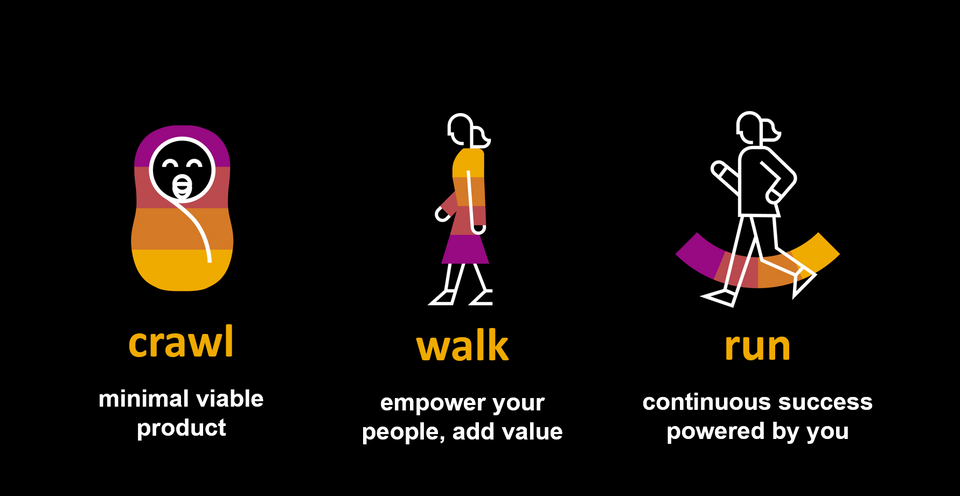
- SAP Community
- Products and Technology
- CRM and Customer Experience
- CRM and CX Blogs by SAP
- Project Delivery Framework for SAP Marketing Cloud
CRM and CX Blogs by SAP
Stay up-to-date on the latest developments and product news about intelligent customer experience and CRM technologies through blog posts from SAP experts.
Turn on suggestions
Auto-suggest helps you quickly narrow down your search results by suggesting possible matches as you type.
Showing results for
Product and Topic Expert
Options
- Subscribe to RSS Feed
- Mark as New
- Mark as Read
- Bookmark
- Subscribe
- Printer Friendly Page
- Report Inappropriate Content
08-01-2023
3:02 PM
Overview

Project delivery framework for SAP Marketing Cloud
The space of digital marketing is a fast paced and constantly evolving environment and so are the people working within it. Digital marketing projects need to live up to high time-to-value, value realization, and agility standards. Our framework and principles are derived from dozens of projects across regions and industries to help you to meet these high standards.
Table of Contents
- Project Delivery Framework Fundamentals
- Delivering SAP Marketing Cloud with SAP Activate
- SAP Activate project example: SAP Model Company
- Conclusion
Project Delivery Framework Fundamentals
Before going into details on how each release and phase works, there is a set of fundamental principles and practices that need to be understood for an SAP Marketing Cloud project. These principles are important across all releases and phases.
- SAP Marketing Cloud can be implemented by applying different project methodologies. However, SAP Activate is a proven methodology that can help you to move fast.
- The project approach for the SAP Marketing Cloud is not strict about agile nor waterfall methodologies. Nevertheless, it is important to follow the principles of agile mindsets.
- The project approach is based on multiple releases and phases within a release.
Delivering SAP Marketing Cloud with SAP Activate
Project Releases & Phases
The project delivery framework for SAP Marketing Cloud as described in this article is aligned with SAP Activate. The image below will provide you with a quick reference of SAP Activate phases for the first release of your digital marketing transformation journey.

Prepare
Provisioning
- Technical availability check
- Initial steps: Connections & Admin Users
Kick-Off workshop
- Corporate & Marketing Objectives introduction
- Project plan introduction
- Identification of business owners, key users, operation owners, technical key resources from customer side
- Articulation of mandates and responsibilities of all involved parties
- Introduction of the steering committee members, cadence, decision process and meeting structure
Explore
Business workshop
- Business scenario identification
- Communication outbound channels definition
- Organizational unit nomination
- Country or regional selection
Technical & functional workshop
- Data source definition
- Feature minimal set definition
- Architecture translation
- Data model & API enhancements
Business foundation activation workshop
- Profiling Match & Merge generic tactic
- Marketing Area common denominator identification
- Permission Marketing configuration in compliance with internal policies
- Authorization granularity
Project Setup
- Fine tuning of the timeline and team member assignments
- Re-validation of scope item backlog based on scenario priorities
- Documentation of all workshop results including the decision criteria per functional and technical item
Realize
The realization activities highly depend on the workshop results from the Explore phase. Based on the multi-release and phased approach we highly recommend you work with a minimal functional and technical set in the first release.
Functional
- Profiling configuration for connected data sources
- Permission configuration
- Segmentation configuration
- Outbound channel configuration
- Content Studio configuration
- Campaign configuration
- Fact sheet configuration
- Business role setup and creation
- Connect SAP Analytics Cloud
- Activate standard analytical stories
Technical
- Connect data sources
- Apply enhancements to the data model and APIs
- Enhance integration packages to comply with enhanced data models or custom Extract-Transform-Load logic
- Create custom integration package to connect to a non-SAP data source via a push method (the source system is pushing data against a custom integration package)
- Apply minor enhancements of views for the Segmentation for custom filters and key figures
Deploy
Technical
- Run integration tests (single and volume) and document the results
- Apply corrections and re-run tests until the minimum quality level threshold is reached
- Migrate the configuration to the production tenant
- Run the initial data migration from the connected sources and start the delta load
- Create a technical operation hand-book and do a hand-over workshop
Business
- Run a production smoke test by applying a seed list and simple campaign
- Build the campaigns identified in the business scenario workshop together with the key business users
- Create a campaign warm-up plan and execute it together with the business and operation team
- Document the created campaigns and warm-up plan campaigns step-by-step as follow-up documentation for the business team
Run
- Hyper-care the campaign warm-up for at least four weeks
- Scope and design the next project wave.
Keep in mind that the organizational and geographical dimension of your second wave will be become more important. You will most likely need to split the second wave into two streams: one to re-iterate the steps above and another one to execute the organizational and geographical roll-out.
Releases and Iteration

SAP Marketing Cloud projects should be broken down into slices or increments called a release following a crawl, walk, run approach. The size of a release can vary depending on the context. When possible, we recommend you schedule releases with relatively equal duration. Smaller releases can help reduce the project's risk, improve time-to-market, and give more immediate visibility to the business and end-users. If you follow the Minimal Viable Product approach paired with the described phases above, your project duration should be between eight to twelve weeks.
SAP Activate project example: SAP Model Company
To learn more about how SAP has configured their own MVP’s for organizations kick-starting their digital transformations, review the SAP Model Company for SAP Customer Experience. SAP’s Model Company offerings are preconfigured MVPs designed for the purpose of meeting MVP timeframes and setting up for the next wave of implementation. As per SAP's implementation process for SAP Marketing Cloud, there are marketing related MVPs serving specific business scenarios, addressing the “The Six Dimensions of Success and Failure”, which are delivered based on a bill of materials purchased by our customers.
Conclusion
This project framework is applicable as a standalone implementation or part of the overall SAP Customer Experience program. You can refer to Overall SAP Customer Experience Project Framework to learn more about the project setup with multiple solutions across the portfolio.
Disclaimer: Original version of this article was published in SAP CX Works.
- SAP Managed Tags:
- SAP Marketing Cloud,
- Customer Experience
Labels:
You must be a registered user to add a comment. If you've already registered, sign in. Otherwise, register and sign in.
Labels in this area
-
Business Trends
270 -
Business Trends
11 -
chitchat
1 -
customerexperience
1 -
Event Information
256 -
Event Information
18 -
Expert Insights
30 -
Expert Insights
49 -
Life at SAP
133 -
Life at SAP
1 -
Product Updates
666 -
Product Updates
26 -
SAP HANA Service
1 -
SAPHANACloud
1 -
SAPHANAService
1 -
Technology Updates
453 -
Technology Updates
15
Related Content
- Clean Core within SAP Sales and Service Cloud extensions in CRM and CX Blogs by Members
- Power of E-commerce Subscription Models in Increasing Conversions and Boosting Average Order Value in CRM and CX Blogs by SAP
- SAP Commerce Cloud Q1 ‘24 Release Highlights in CRM and CX Blogs by SAP
- Is your organization ready for a marketing transformation? in CRM and CX Blogs by SAP
- CRM Basic Technical Info for ABAPers in CRM and CX Blogs by Members
Top kudoed authors
| User | Count |
|---|---|
| 2 | |
| 1 | |
| 1 | |
| 1 | |
| 1 | |
| 1 | |
| 1 | |
| 1 | |
| 1 |